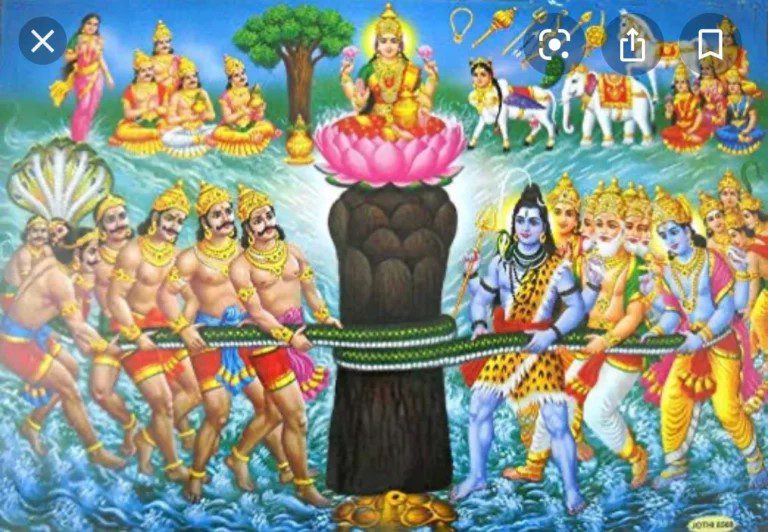
Sequences Of Civilizational Ascendance
Seeing events as sequential and consequential actions defines a resolved person, that is the purpose of all education to bring down the unlimited chaos into tangible sequences and consequential steps which unriddle existence even for a simple person. Such resolved mind, which sees through existence, has the capacity to create institutions, build civilization, which is a web of ever young and vibrant institutions creating and driving societies. But to have such a vision a person must have Experience which is, knowing that there is something above physical senses. Such an experience will refine the way we use sense organs for data collection. That is when ascendance of a Person or society happens. This ascending nature is Called Udgati which is mentioned in Vedas, Upanishads and Puranas. There is a story in Chandogya Upanishad which talks about the war between Suras and Asuras both progeny of Prajapati , who ,for dominance, go for war. To win this war, Suras perform the yagna of Udgatir which is basically yagna of ascendance, which explains the strategy of winning life battles and ascending. The Upanishad mentions sequence of steps as part of this yagna which all culminate to Udgati. There are multiple such sequences in Chandogya Upanishad, which talks about the path of ascendance, required for understanding and implementation of Udgati. We find sequence and structure all over Vedas, Upanishads, Puranas, Festivals etc which give or show us the path of ascendance. Another such sequence is the festival of Dasara which comes in the Dakshinayanam of the year which starts with Balatripura Sundari and culminates with RajaRajeshwari, the sequence of forms Devi takes throughout those 9 days of Navaratri explains the ascendance of shakti from being a small innocent form i.e Bala, to, becoming the Goddess of the king of Kings. Then, there is an enigmatic sequence of Kaala himself which is reflected in the science of Jyotishya, the source and validation of all sequences emerged in time. Jyotishya has codified the enigmatic sequences of Kaala as a structured subject, which can be passed down as a science, for people to perceive time/change. Essence of all such Sequences when extracted, will give us templates which can be used at personal and social levels for people and society to understand repeated patterns of occurring events. Knowledge passed down in this refined form enhances intellectual capacity of people as they access readily available information using the templates instead of behaving just as memory bags.
Let us now delve into one sequence present in Bhagavata Puranam i.e. the story of Samudra Mathanam. This story has background where sequence of events happens before Suras and Asuras start to get items out of Ksheera Sagaram which is the imperishable Ocean of worldly existence. When Suras and Asuras get on, for achieving Amrutham (meaning: Not Dying / Living Eternally) and churn the ocean using Vasuki ( meaning : Vasanas) 1st item which comes out is Halahalam ( meaning : Un resolving Obstacles) which will be taken by desireless Shankara. 2nd Item which comes out is Kamadhenu (meaning: Desire fulfiller) which will be taken by Rishis (meaning : Who won over Desires) , who in turn will use Kamadhenu to do Yagna for sustenance. 3rd item is Uchaishravam (meaning: Listening Higher voices/meaning) which is given to Bali (meaning : Sacrificed ). 4th item is Kalpa Vruksham (meaning: Alternative/Desired Growth) which is taken by Devendra, the King of Suras. 5th item is Apsarasa (meaning : juicy cravings). After cravings are fulfilled, then comes 6th , Mahalakshmi ( meaning : great wealth) which lays foundation for the 7th , Chandra ( represents : Healthy mind, Soma, popularity, Reputation, Credibility etc) which leads to 8th item of Amrutham ( meaning : Not Dying / Living Eternally) which is fickle and dependent on 7th Item of Chandra , which in turn dependent on 6th Mahalakshami , which depends on fulfilling Desires and goes back further . In this story, all the sequences culminate to ascendance till Amrutham, later in the story there is another sequence which happens and gives us further knowledge.Concepts of ascendance in all such stories are explained through the choice of words and details of actions/rituals. For example, we can use this given sequence as a template for understanding and establishing institutions which are lasting or eternal (Amrutham). In this world of never-ending chaos and regeneration, the story of Samudra Mathanam is relevant at every age. There many such sequences given to us as stories and Mantras which teaches and helps, as tools for Udgati of Humanity.


Lokesh
Well explained pranav